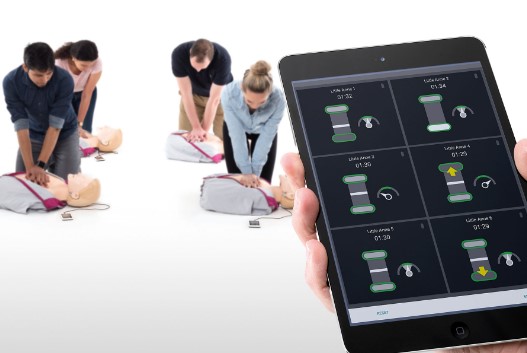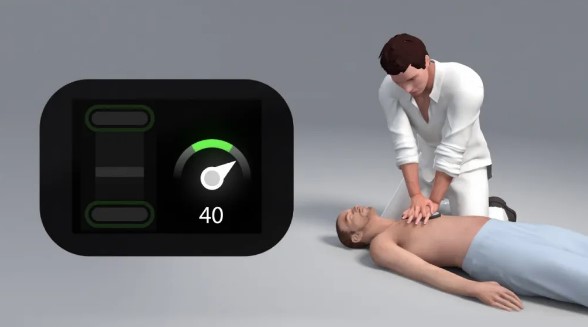What Does a Chest Compression Feedback Device Monitor

Life-saving measures, like Cardiopulmonary Resuscitation (CPR), demand precision and quality in their execution. A key component in this process is chest compressions, and understanding the necessity of correct execution, the healthcare industry has seen the emergence of chest compression feedback devices. Let’s delve into the fascinating world of what does a chest compression feedback device monitor.
The Science Behind What Does a Chest Compression Feedback Device Monitor

Chest compression feedback devices are technological marvels designed to elevate the efficiency and effectiveness of CPR by providing real-time feedback. They monitor essential metrics related to chest compressions, including compression depth and rate. The depth and rate of chest compressions are critical to ensure sufficient blood circulation to the heart and brain, which can be the difference between life and death during resuscitation.
These devices integrate advanced chest compression sensor technology, providing invaluable data that aid in CPR performance evaluation. The feedback from these devices can alert the rescuer about the quality of compressions, facilitating immediate corrections if necessary.
The Multifaceted Benefits of Chest Compression Feedback Devices
It’s evident that Chest Compression Feedback Devices offer multifaceted benefits in enhancing CPR quality. These devices optimize compression depth, rate, and recoil, crucial for effective resuscitation. They provide real-time feedback, aiding rescuers in maintaining proper technique, potentially improving patient outcomes. Additionally, these devices facilitate training by offering objective performance metrics. Overall, their integration into CPR protocols promises to elevate the quality of chest compressions, potentially saving more lives in cardiac arrest scenarios.
The Universality of Chest Compression Feedback Devices

Can chest compression feedback devices work for both adults and children? Yes, they certainly can! Many of these devices are versatile and adaptable, able to provide feedback for both adult and pediatric CPR. The real-time compression feedback facilitates a tailored approach for each patient, ensuring optimal care regardless of age.
Chest Compression Feedback Devices as a CPR Training Aid

Training in CPR can be a challenge. However, chest compression feedback devices are a game changer in this realm. They are excellent tools for CPR technique assessment and are increasingly being integrated into CPR training programs. By providing trainees with immediate feedback on their technique, these devices ensure more effective learning and retention of CPR skills.
Scientific Consensus on What Does a Chest Compression Feedback Device Monitor
Research and studies have consistently highlighted the effectiveness of chest compression feedback devices. A study published in the Journal of the American Heart Association concluded that these devices significantly improved CPR quality. Thus, they are instrumental in resuscitation effectiveness evaluation.
Are There Any Limitations to Chest Compression Feedback Devices?
While chest compression feedback devices offer a host of benefits, they are not without their drawbacks. For instance, they require competent use and understanding to be effective. Over-reliance on the device can sometimes lead to complacency in manual skill development. However, with proper use and guidance, the benefits of these devices far outweigh the limitations.
Choosing a Chest Compression Feedback Device
There are numerous types of chest compression feedback devices available on the market, each with unique features tailored to specific needs. When choosing a device, consider factors like ease of use, accuracy, versatility, and compatibility with your CPR protocol. Remember, the best device is the one that enhances your CPR performance and confidence.
Incorporating Feedback Devices in CPR Training Programs
Chest compression feedback devices have become essential tools for modern CPR training. By offering real-time feedback, these devices allow trainees to immediately correct their technique, reinforcing the learning process. This hands-on approach ensures that learners are not just memorizing steps, but understanding the implications of each compression, making them better prepared to face real-life scenarios.
The Future of Chest Compression Feedback Devices
Given the rising consensus about their effectiveness, chest compression feedback devices are poised for more widespread adoption. Advancements in technology will likely lead to the development of devices with enhanced features, providing even more precise feedback, and perhaps incorporating AI capabilities to offer predictive insights.
Moreover, the use of these devices is likely to extend beyond professional healthcare settings. With the importance of bystander CPR in saving lives, these devices could soon become common household items, empowering everyone to perform effective CPR.
The Role of Chest Compression Feedback Devices in Research
Chest compression feedback devices are not just useful in practice, but also serve a crucial role in research. With their ability to provide precise measurements, these devices offer a wealth of data for analysis. This can contribute to ongoing studies about the most effective CPR techniques, pushing the boundaries of our current understanding and driving the evolution of CPR guidelines.
Frequently Asked Questions
How does a chest compression feedback device work?
A chest compression feedback device works by using sensors to monitor and evaluate the quality of chest compressions. It provides real-time feedback on aspects such as compression depth, rate, and hand placement.
Can a chest compression feedback device detect incorrect hand placement during CPR?
Yes, many chest compression feedback devices have the capability to detect incorrect hand placement during CPR and provide real-time correctional feedback.
How accurate are chest compression feedback devices in monitoring CPR performance?
Chest compression feedback devices are known for their high accuracy in monitoring CPR performance, contributing significantly to the improvement of CPR quality.
Are there any guidelines or standards for using chest compression feedback devices?
Guidelines for the use of chest compression feedback devices largely align with CPR guidelines provided by organizations like the American Heart Association (AHA) or European Resuscitation Council (ERC). They recommend the use of feedback devices to enhance the quality of chest compressions.
What are some recommended chest compression feedback devices on the market?
There are several high-quality chest compression feedback devices available in the market. Some of the popular ones include the ZOLL R Series Defibrillator, Philips HeartStart MRx with Q-CPR, and the Laerdal CPRmeter 2. Always select a device that best fits your needs and level of comfort.
Also Read: Bertram Williams Jr. – All You Need to know About Him
Conclusion
Chest compression feedback devices are undeniably a turning point in the world of CPR. They monitor and enhance the quality of chest compressions, offer invaluable training aid, and play a pivotal role in resuscitation research. While they have their limitations, the benefits are abundant and their potential for the future is exciting. These devices truly embody the spirit of innovation in healthcare, providing us with the means to improve and save more lives. Let’s embrace this advancement and look forward to a future of even more efficient and effective about what does a chest compression feedback device monitor.



![Spring Valley Weight Management Gummies [2024] 10 Spring Valley Weight Management Gummies](https://knwonzee.com/wp-content/uploads/2023/07/Spring-Valley-Weight-Management-Gummies-768x432.png)


